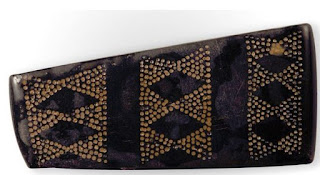See also, the Round Mounds blog in the sidebar.
 |
| Jet plate Via BBC |
It appears the archaeologists have already been able to reassemble the necklace and have said it is crescent shaped, though the final assembly has not been publicized. Jet black seems to have been a luxury item worn by women during the Beaker period, mostly in Britain, and then mostly in Northeastern Britain. The archaeologists seem to think this material made its way from Whitby, North Yorkshire.
This is an important find for understanding the Beaker period of the Isle of Man. For one, it shows that the people living on Man were more connected to the outside world than previously thought. Importantly for Man is the fact that they have skeletal remains of a (probable) Beaker for the first time (the other burials have all been cremations). This individual (maybe a woman) may answer some questions about the settlement of the island and the integration of the previous natives if her ancestry is significantly mixed, or not. There appears to be an isotope and DNA analysis underway and that will be huge.
 |
| jet plate via BBC |
The Berk Farm necklace really changes how prehistoric Man may be viewed in the context of the neighboring islands. These people were wealthy enough, or shallow enough, to desire fine things from distant places. Or maybe they were just shallow people from distant places. Isotopes may tell.
 |
| Fowler and Crellin via BBC |
See the Newcastle University release


Do you think there's any connection between Bell Beaker gold lunulae and Egyptian gold collars?
ReplyDeleteNot a direct correspondence that I've seen, however there are some metaphorical associations that are noteworthy.
ReplyDeleteFor one, it appears that quite a few of the Old Kingdom gold collars have falcon heads, which are solar associated animals in mythology, including that of Horus. The Bell Beaker lunulae appear to be skeumorphs of a solar boat. Metaphorically, there is some connection.
I've talked about this here.
https://bellbeakerblogger.blogspot.com/2015/07/sailboats-and-solarboats.html
Although there would have been differences between Beaker religion and Egyptian religion of this time, some mythological narratives probably haddeep roots in Early Near Eastern Neolithic. Other ideas may have been inspired or borrowed in contemporary times, either through migration or contact.
https://bellbeakerblogger.blogspot.com/2016/01/symbolism-metaphors-beaker-underworld.html
The Bell Beakers were very active around the entire Western Mediterranean and North Mediterranean at a time when the influence of Egypt was spreading in all directions, so some exchange of ideas surely happened, although I'm not sure to what extent the gold collars factor.
I just read this, regarding archaeology in Bulgaria:
Delete"lunula-like breast decorations, shaped as a ‘collar’, made of whole gold or bronze sheet – single or composed of separate, situated in bands elements – are observed both in representations and among archaeological material from the third – second millennia BC, coming from a broad geographic area: from Anatolia, Asia Minor and Egypt to the regions of the middle and upper course of the Danube River in the west, and to the British Isles in the northwest."
https://historymuseum.org/mobile/en/digital-resources/kolektivna-nahodka-ot-panajot-hitovo-ii-hil-pr-hr/
There's some evidence that gold metallurgy was introduced to the Levant from Europe (the Varna culture) and from there to Egypt. This apparently involved a migration from either the Balkans or Anatolia to Israel and from there into Egypt:
'Ancient DNA from Chalcolithic Israel reveals the role of population mixture in cultural transformation' (2018)
https://www.ncbi.nlm.nih.gov/pmc/articles/PMC6102297/
'Ancient genomes from North Africa evidence prehistoric migrations to the Maghreb from both the Levant and Europe' (2018)
https://www.pnas.org/content/115/26/6774.long
The earliest gold in the Levant (from the Nahal Qanah cave in Israel) has the same composition as gold from the Balkans and artefacts from the Varna culture:
'Earliest gold artefacts in the Levant' (1990)
https://www.researchgate.net/publication/249178934_Earliest_Gold_Artifacts_in_the_Levant
'On the invention of gold metallurgy: The Gold Objects from the Varna I Cemetery' (2015)
https://www.researchgate.net/publication/276527606_On_the_Invention_of_Gold_Metallurgy_The_Gold_Objects_from_the_Varna_I_Cemetery_Bulgaria-Technological_Consequence_and_Inventive_Creativity
Gold beads from the same period found in another cave in Israel have the same metal composition and were found with carnelian beads similar to those in Varna culture burials:
'Deep caves in the Ancient Near East' (2017)
https://www.degruyter.com/downloadpdf/j/jlecol.2017.10.issue-3/jlecol-2017-0027/jlecol-2017-0027.pdf
Varna culture artefacts include lunula-shaped gold pendants. The Trabzon hoard from the south-east coast of the Black Sea has clear connections to the Varna culture and features a large gold lunula pendant/collar.
https://i.imgur.com/aepJ8Yb.png
https://i.imgur.com/bXCqzMn.jpg
These gold pendants in turn have close similarities to boar tusk pendants from the Giurgiuleşti cemetery in southern Moldova, belonging to the Suvorovo-Novodanilovka culture:
'The circum-Aegean area in the 5th and 4th millenia BC' (2018)
https://books.google.co.uk/books?id=ARRHDwAAQBAJ&pg=PA104&lpg=PA104&dq=trabzon+hoard+larger+sickle-shaped&source=bl&ots=ENPHM2qRGG&sig=ACfU3U241MwqnL2nXTL6v44dDrhtLjCJzw&hl=en&sa=X&ved=2ahUKEwiwrt6u9OTkAhXbTBUIHTJIBlUQ6AEwEnoECAkQAQ#v=onepage&q=trabzon%20hoard%20larger%20sickle-shaped&f=false
'The Lost World of Old Europe' (2010), p.219
https://e-edu.nbu.bg/pluginfile.php/586999/mod_resource/content/1/Anthony%20et%20al%20ed_2010_The%20Lost%20World%20of%20Old%20Europe%20Catalogue.pdf